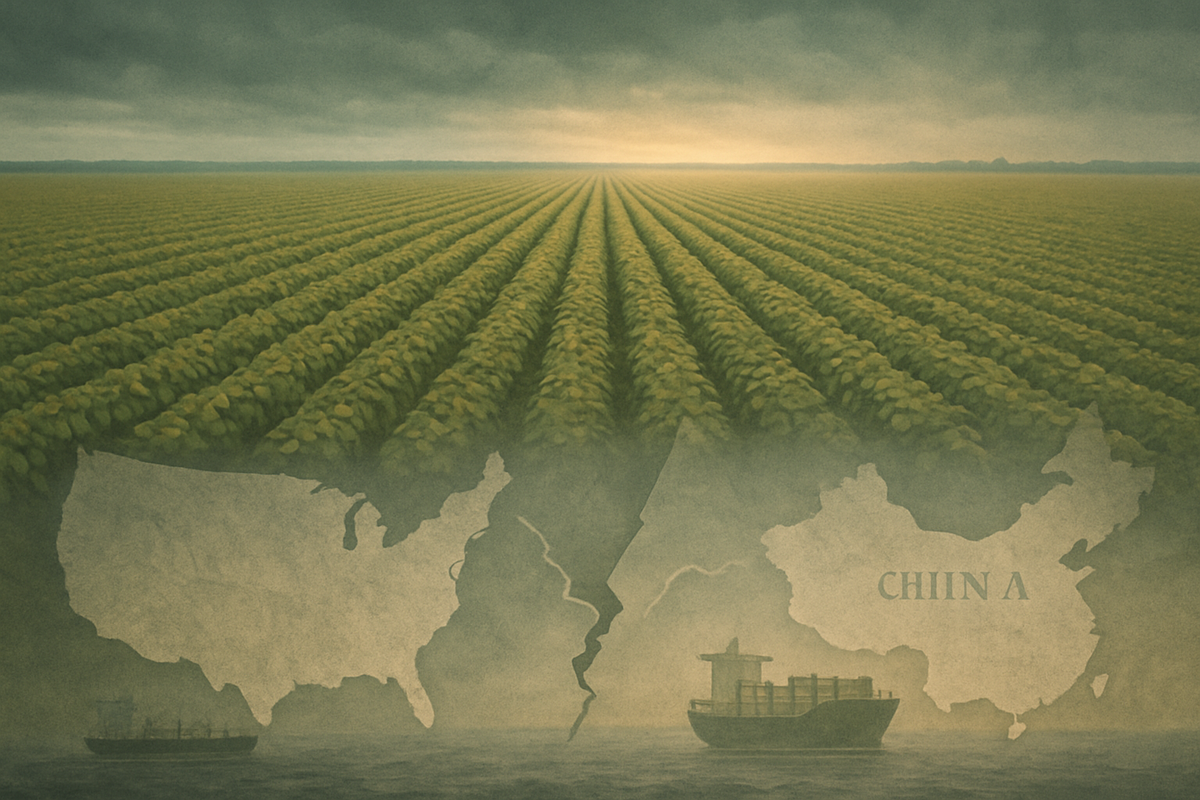
The American agricultural system finds itself at a critical juncture, grappling with the long-term ramifications of diminished demand from its historically largest soybean buyer, China. As of October 2025, U.S. soybean farmers face significant financial strain, plummeting prices, and an unprecedented glut of unsold crops, largely a consequence of the lingering US-China trade tensions that began in 2018. This structural vulnerability has necessitated a continued reliance on government trade-related farm aid plans, which, while offering a crucial lifeline, are increasingly seen as temporary fixes rather than sustainable solutions for a market fundamentally reshaped by geopolitical shifts and China's strategic diversification of its food supply.
The immediate implications are stark: U.S. agricultural exports to China fell nearly 40% between June 2024 and June 2025, with soybean shipments in recent months being "effectively zero." This dramatic reduction in demand, coupled with increased U.S. production expectations, has driven soybean futures down by over 5% in a short period, pushing prices well below the cost of production for many farmers. The ongoing market disruption highlights deep-seated flaws in an agricultural model heavily reliant on a single major export market, forcing a painful reevaluation of planting strategies, market access, and the very future of American farming.
The Shifting Sands of Global Agricultural Trade: A Deep Dive into China's Retreat
The current predicament of the U.S. soybean market is a direct consequence of a series of strategic maneuvers and retaliatory actions that began half a decade ago. The catalyst was the US-China trade war, ignited in 2018, which saw China impose a 25% retaliatory tariff on U.S. soybeans. By October 2025, the cumulative duty rate on U.S. soybeans for China, encompassing retaliatory tariffs, Most Favored Nation (MFN) tariffs, and Value Added Tax (VAT), had escalated to 34%, effectively rendering American soybeans uncompetitive in the Chinese market. This pricing disadvantage has been a persistent barrier, fundamentally altering trade flows.
Beyond punitive tariffs, China (Shanghai: 601857) has aggressively pursued a long-term strategy of diversifying its soybean suppliers, aiming to enhance its domestic food security and reduce its dependence on any single nation, particularly the United States. This strategic pivot has seen a significant surge in purchases from South American giants like Brazil (BM&FBovespa: B3SA3) and Argentina (Buenos Aires: BCBA:GGAL). Brazil, in particular, has cemented its position as China's dominant supplier, accounting for 71% of China's soybean needs in 2024, while the U.S. market share plummeted to a mere 12%. China has also invested in domestic agricultural policies to boost its own soybean production and has explored adapting to low-protein feed formulas to curb its overall demand for imported soymeal.
The timeline of events paints a clear picture of this evolving crisis. Following the initial imposition of tariffs in 2018, U.S. soybean exports to China, which historically accounted for an average of 28% of U.S. production, began a precipitous decline. While there were brief periods of increased purchases under the "Phase One" trade deal, these proved to be temporary reprieves. By June, July, and August 2025, U.S. soybean exports to China were "effectively zero," a stark contrast to the nearly 25 million metric tons shipped in marketing year 2023/24. From January through August 2025, total U.S. soybean exports to China amounted to only 218 million bushels, a dramatic drop from 985 million bushels in 2024.
Key players in this unfolding drama include the U.S. Department of Agriculture (USDA), which has been tasked with managing the fallout and implementing aid programs, and U.S. soybean farmers, who are bearing the brunt of the financial losses. The initial market reactions have been severe: new crop November 2025 soybean futures fell by over $0.51 per bushel (5%) between July 18 and August 6, 2025, pushing prices near $9 per bushel, significantly below the estimated production cost of $12.05 per bushel. This has led to reported losses of $100-$200 per acre for farmers, widespread accumulation of unsold crops, and challenging storage logistics, with some farmers resorting to storing soybeans on the ground. The issue is further compounded by low water levels in the Mississippi River, which have driven up barge rates and increased transportation costs to alternative markets.
Corporate Repercussions: Winners and Losers in a Reshaped Agricultural Landscape
The seismic shifts in global agricultural trade, driven by China's reduced soybean appetite and the US government's responsive farm aid, are creating distinct winners and losers among public companies within the agricultural sector as of October 2025. While some globally diversified players may find avenues to mitigate losses or even capitalize on new supply chains, many U.S.-centric agricultural firms and equipment manufacturers are facing significant headwinds.
Companies with substantial exposure to U.S. agricultural exports and the domestic U.S. farm economy are feeling the most pronounced negative impacts. Agricultural commodity traders like Archer-Daniels-Midland (NYSE: ADM) and Bunge Limited (NYSE: BG), while global behemoths, have reported considerable declines in earnings. ADM, for instance, saw a 53% year-over-year drop in Q2 2025 earnings before income taxes, explicitly citing "U.S. trade upheaval." Bunge missed Q2 revenue forecasts by a significant margin, attributing it to weak oilseed crush margins and trade disruptions. While these companies possess global footprints, their U.S.-origination operations are struggling with lower volumes and increased storage costs for American-sourced soybeans.
The strain on farmer profitability directly translates to reduced demand for agricultural inputs and equipment. Companies such as Corteva Agriscience (NYSE: CTVA), Bayer AG (XTRA: BAYN) (owner of Monsanto), and Nutrien Ltd. (NYSE: NTR) are likely experiencing a downturn in sales of seeds, fertilizers, and crop protection products. As farmers grapple with lower crop prices and financial uncertainty, capital expenditures are being curtailed, impacting these suppliers. Similarly, agricultural equipment manufacturers like Deere & Company (NYSE: DE), AGCO Corporation (NYSE: AGCO), and CNH Industrial (NYSE: CNHI) face a prolonged slump. Deere, which estimated approximately $500 million in annual tariff exposure, lowered its full-year net income outlook in Q3 2025, attributing it to weaker crop demand, lower grain prices, and ongoing trade tensions. These manufacturers are scaling back production and destocking inventories as retail demand softens and farmer sentiment remains cautious.
Conversely, the "winners" in this scenario are primarily entities with strong presences in South America. While not U.S. public companies, Brazilian and Argentine agribusinesses are benefiting immensely from China's pivot. Among U.S. public companies, those with robust South American operations are better positioned to leverage the shift. Bunge Limited (NYSE: BG), despite its overall revenue challenges, is relatively better situated due to its extensive crushing and export infrastructure in Brazil and Argentina. The surge in Chinese demand for South American soybeans allows Bunge to capitalize on these operations, potentially boosting its crushing margins and export revenues from those regions. Similarly, Archer-Daniels-Midland (NYSE: ADM), through its global diversification, can pivot its sourcing to lower-cost producers in South America, with its Brazilian operations becoming a key supplier to China, helping to offset the difficulties faced by its U.S.-centric segments.
The U.S. government's trade-related farm aid plans, including a potential new bailout package ranging from $10 billion to $15 billion and the $10 billion earmarked by the American Relief Act of 2025, are designed to support farmers directly. However, their impact on public companies is largely indirect and limited. While this aid provides a crucial lifeline to help farmers stay afloat, preventing widespread bankruptcies that would further depress demand, analysts caution that such payments are "unlikely to drive a rebound in machinery sales" as farmers historically do not spend government aid on new equipment. For input providers, the aid might stabilize demand to some extent, but it does not resolve the fundamental issue of lost market access and the long-term shifts in crop rotation away from soybeans that will continue to suppress demand for their products.
A Global Reordering: Broader Trends and Geopolitical Ripples
The diminished role of U.S. soybeans in the Chinese market is more than a fleeting trade dispute; it signifies a profound reordering of global agricultural trade, with far-reaching implications for industry trends, international partnerships, and policy frameworks. This shift, cemented by October 2025, reflects both China's strategic imperatives and the U.S.'s evolving response to a less predictable global marketplace.
A primary broader industry trend is the accelerated diversification of trade partners. For China, this means solidifying its reliance on South American nations. Brazil (BM&FBovespa: B3SA3) and Argentina (Buenos Aires: BCBA:GGAL) have emerged as the undisputed primary suppliers of soybeans to China, with Brazil alone accounting for 71% of China's soybean imports in 2024. Initiatives like "Soy China," aimed at developing soybean varieties tailored for Chinese standards, underscore China's long-term commitment to these alternative supply chains. This has propelled Brazil to surpass the U.S. as the world's largest soybean producer and exporter. For the United States, the response has been a concerted effort to find new markets. The U.S. Department of Agriculture (USDA) launched the Regional Agricultural Promotion Program (RAPP), injecting $600 million in 2024 to help U.S. exporters expand into emerging markets across Africa, Latin America, the Caribbean, and South/Southeast Asia. Domestically, the burgeoning renewable diesel sector is also driving an increase in U.S. soybean crush capacity, providing a new avenue for absorbing some of the surplus.
The ripple effects on competitors and partners are substantial. South American agricultural powerhouses are clear beneficiaries, experiencing increased demand and investment, which in turn fuels their production capabilities. Conversely, countries that previously relied on U.S. soybeans for their processing industries might face higher prices or need to adjust their sourcing strategies if the U.S. prioritizes domestic crush or new export markets. Regulatory and policy implications are also significant. The U.S. continues to explore various trade tools, including potential increased tariffs on Chinese goods or even the revocation of China's Permanent Normal Trade Relations (PNTR) status, which could further escalate tensions. China, for its part, has signaled a willingness to resume U.S. soybean purchases if "unreasonable tariffs" are removed, highlighting the political nature of these trade barriers. Both nations are driven by national food security concerns, shaping their respective agricultural policies.
Historically, agricultural trade disputes and government interventions are not new phenomena. The interwar period saw widespread protectionism, with countries raising tariffs and implementing subsidies to protect their farmers from falling prices – a scenario that echoes today's farm aid programs. The post-World War II era, with the establishment of the General Agreement on Tariffs and Trade (GATT), attempted to liberalize trade, but agriculture remained a sensitive sector, often excluded from standard rules. The World Trade Organization (WTO) era has consistently seen agriculture generate a disproportionate share of trade disputes. The most immediate historical precedent is the 2018 US-China trade war itself, which demonstrated how retaliatory tariffs could decimate agricultural exports and necessitate massive government aid, setting the stage for the current situation. The current environment reinforces the lesson that agricultural trade is deeply intertwined with geopolitical relations and national strategic interests, making it highly susceptible to disruption.
Navigating the Future: Strategic Pivots and Emerging Realities
As the U.S. agricultural system confronts a new era defined by China's enduring shift away from American soybeans, the path forward necessitates significant strategic pivots and adaptations. The outlook for the coming months and years, as of October 2025, is marked by both formidable challenges and emerging opportunities for resilience.
In the short-term (late 2025 - early 2026), the U.S. agricultural sector is bracing for continued headwinds. USDA forecasts predict a further decline in agricultural exports to China, potentially reaching $9 billion by 2026, the lowest since the 2018 trade war. This downturn extends beyond soybeans to include corn, wheat, sorghum, pork, and cotton. Consequently, commodity prices are expected to remain depressed, exacerbating the financial strain on farmers, who are already seeing crop cash receipts at their lowest levels since 2007. The widening U.S. agricultural trade deficit, projected to hit $47 billion by the end of fiscal year 2025, underscores the severity of the situation. While the Trump administration is planning significant aid packages, a federal government shutdown in October 2025 has temporarily delayed their distribution, adding another layer of uncertainty. Meanwhile, South American producers, particularly Brazil, are set to solidify their dominance, projected to produce 42% more soybeans than the U.S. in marketing year 2024/25.
Looking long-term (2026 and beyond), the industry must prepare for a landscape where China's reduced reliance on U.S. agriculture is likely a permanent structural change. China's food security goals and its desire to avoid dependence on any single nation mean that even if tariffs are eventually removed, previous sales volumes are unlikely to fully resume. This necessitates a fundamental strategic reorientation for the U.S. agricultural sector. The most crucial adaptation is aggressive market diversification. Organizations like the U.S. Soybean Export Council (USSEC) are actively working to differentiate U.S. soy and build new partnerships in over 80 countries, targeting emerging economies in Southeast Asia, Africa, and Latin America with growing demand for oil, high-quality soy foods, and soybean meal. The USDA's Regional Agricultural Promotion Program (RAPP) and new trade missions are vital components of this push.
Beyond geographical diversification, product diversification and value-added processing offer significant opportunities. Farmers may need to explore alternative crops beyond traditional commodities or invest in processing to create higher-margin products, such as high-oleic soybeans, soy-based bioplastics, protein isolates, or biofuels. This shift moves beyond simply exporting raw commodities to capturing more value within the supply chain. Enhanced risk management strategies, including robust federal crop insurance and diversified marketing plans, will be essential for farmers facing increased market volatility. Furthermore, the adoption of technological innovations – from precision agriculture and AI-driven decision-making to blockchain for traceability – can improve efficiency, reduce costs, and enhance market competitiveness and consumer trust.
However, significant challenges persist. The specter of persistent tariffs and potential trade escalation remains, with proposals for even higher tariffs on Chinese goods by a potential new administration threatening further retaliation. A strong U.S. dollar makes American exports less competitive globally, while high production costs continue to squeeze farmer profit margins. The solidified competitive advantage of South American producers means a long-term loss of market share for the U.S. in key regions. Moreover, supply chain disruptions due to geopolitical events, climate change, and logistics bottlenecks continue to cause price swings. Domestically, without robust export markets, there's a risk of oversupply, further depressing prices. Navigating these complexities will require sustained government support, industry collaboration, and individual farmer adaptability to forge a more resilient and diversified agricultural future.
Conclusion: A New Dawn for American Agriculture?
The current state of American agriculture, as of October 2025, is one of profound transition and persistent challenge. The structural flaws in a system heavily reliant on a single dominant export market have been starkly exposed by China's strategic pivot away from U.S. soybeans. This shift, driven by China's long-term food security goals and geopolitical tensions, has created a new, more volatile reality for U.S. farmers and agribusinesses.
The key takeaways are clear: U.S. agricultural exports to China, particularly soybeans, have plummeted to unprecedented lows, with little expectation of a full recovery to pre-trade war levels. This has resulted in significant financial strain for farmers, characterized by depressed commodity prices and stubbornly high input costs. Government trade-related farm aid, while providing crucial short-term relief, is not a sustainable replacement for robust market access and highlights the need for a more resilient agricultural policy framework. The ongoing U.S. government shutdown has further complicated matters, delaying aid and creating an "information vacuum" during a critical harvest period. Meanwhile, South American competitors, especially Brazil, have solidified their position as the primary suppliers to the Chinese market, fundamentally reshaping global supply chains.
Moving forward, the market will likely remain volatile. Commodity prices, particularly for grains, are projected to continue their decline, although some input costs may ease. The long-term significance of these events is a lasting reorientation of global agricultural trade, compelling the U.S. to aggressively pursue market and product diversification. The emphasis on technological advancements, such as precision agriculture and biotechnology, coupled with sustainable farming practices, will be crucial for enhancing efficiency and competitiveness in this new environment. The repeated reliance on government aid also underscores the need for more comprehensive risk management strategies at the farm level and stable, predictable trade policies.
Investors in the agricultural sector should pay close attention to several key indicators in the coming months. Firstly, monitor any developments in U.S.-China trade negotiations, although a significant rebound in Chinese soybean purchases is unlikely. Secondly, keep a keen eye on South American production forecasts and export volumes, as their continued dominance will dictate global soybean prices. Thirdly, assess the effectiveness and rollout of U.S. farm aid packages, particularly in mitigating farmer financial distress and influencing future planting decisions. The resolution of the government shutdown is an immediate concern, as its continuation will delay vital support and market data. Finally, observe the success of U.S. efforts to diversify export markets into regions like Southeast Asia and Africa, as this will be a critical determinant of the sector's long-term health. While short-term challenges abound, the underlying global demand for food, coupled with technological innovation, suggests that U.S. agriculture, though transformed, will continue to play a vital role, albeit with a new strategic compass.
This content is intended for informational purposes only and is not financial advice





